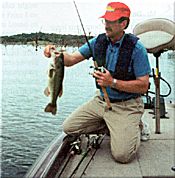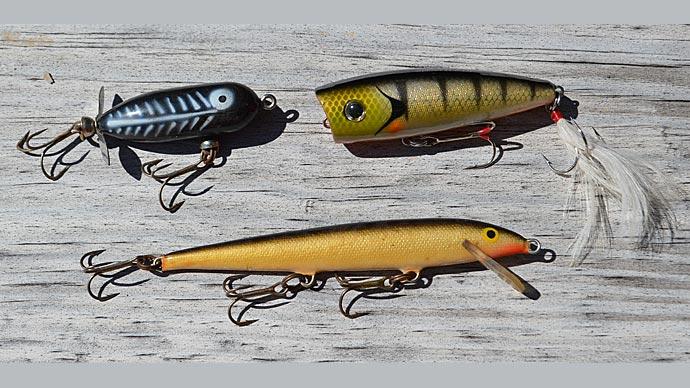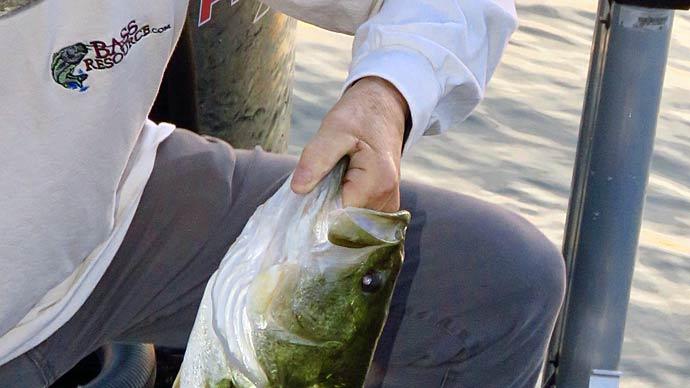
Bass fishermen have always had a hallowed place in their hearts for topwater baits. After all, you can't honestly explain the excitement of a topwater strike to a beginner until they experience the first explosion of a largemouth bass as it crashes the surface and engulfs a plug. Yet many folks will have a jillion soft plastics and only a few topwater plugs.
The topwater plugs do have some liabilities as fish producers. To begin with, they are warm-water baits and therefore aren't productive for a chunk of the year. They are often considered early, late, and nighttime plugs, even during the warm-water months. The reason for this is simple. This is when bass are more likely to be in shallower water, or shallower strata, of any given depth where you can get them to hit a bait on the surface. This is mainly because the bass would prefer to avoid bright sunlight by playing the shadows or structures as holding places. But a bass is a predator driven by the need for food. Shad aren't as sensitive to concerns about direct sunlight and thus will often "take" the bass with them to more open water. This can result in feeding frenzies where chasing schools of bass break the surface during warm weather.
Looking at some of these points, we begin to get a handle on choosing the right time to throw a topwater plug. You can usually forget topwaters during cold-water conditions (generally when the surface temperature is below 65 degrees). However, it is essential to check the surface temperature since brisk air temperatures can fool you when the water is still quite warm in the fall. The reverse is true in the spring when the backs of coves may be as much as 10 degrees warmer than the open water. Mainly this is true on bluebird days, with no wind, and on the east banks where the afternoon sun can rapidly warm the shallows. Bass will strike the subsurface, even if it is only six inches below the surface when they can't be forced to go all the way up on true topwater baits.
This observation opens the door for a broader range of baits, which float on top but can be worked for periods of the retrieve as subsurface lures. These are, of course, the minnow-like jerkbaits such as a Red Fin, Rogue, or a Speed Wake.
So, are there simple guides other than the warmth of the water, time of day, and possibly the depth of water (since most topwaters are usually worked in shallower water, with some exceptions we will discuss later)? One interesting indicator is if you see turtles on logs during the late fall or early spring periods. These creatures are good indicators of enough warmth in that area that they are coming up to sun themselves. No, this doesn't mean you can fish a pure topwater, but I guarantee you can get hits on the topwater shallow-swimming jerkbaits because bass have also sensed that warm-up.
During the warm months, be alert for any breaking fish. The bass will take a topwater bait if there are swirls or actual breaks in the area. They will also take subsurface lures at this time, so there are only a few rare cases where topwaters are advantageous in producing numbers of fish over other baits. Schooling bass, as mentioned, will also hit topwaters, but often the plug has to be matched closely to the size of the forage bait. During schooling activity on bright clear days in clear-water lakes, you may get more hits from a clear plug than one that shows up too well.
If you are working topwaters for scattered, individual bass, you need to recognize the importance of lure size to the number of strikes. A smaller topwater will always get more hits than a larger bait, but the larger the plug, the better the quality of the fish. For this reason, plugs such as the Zara Spook became topwater plugs of choice by tournament fishermen a few years ago.
Topwater plugs must be worked in certain retrieves to be most productive on a given day. This can include selected variations in the speed of retrieve on the cast to the amount of noise you cause by the bait on retrieve. Each plug type performs only as well as your ability to resolve the presentation that triggers strikes on that given day. The extremes of the retrieve included the concept of a topwater purist I once knew who swore by the need to let the ripples die before moving the bait. Most strikes occur when you are inducing action in the plug, either when you start the movement, vary movement (if using a more rapid retrieve), or stop the plug. Among all these options, nothing triggers a strike from a feeding bass more readily than the concept that food is getting away. That concept has to be tempered with the fact that we often catch bass, particularly on topwaters, as they react to the plug. This means you can occasionally force a strike by "irritating" the fish.
The action of some topwater plugs is evident. For example, the only difference with a chugger, popper, or a topwater plug with a spinner is in the amount of noise you create as you work the bait. On the other hand, stickbaits such as a Devil's Horse or its thicker cousin, the Zara Spook, have a whole array of presentations available. Perhaps the most common retrieve is to "Walk the dog," which means to dart the bait from side to side by moving the rod tip from side to side as you retrieve the bait. On the other hand, these plugs can dip in place and pop back very close to the original position in the water. This can drive a bass nuts by seeing the critter do a dance over his head.
Choices for colors in topwater plugs cover the whole range of patterns. First, you must select a couple of representative baits to give you the actions mentioned above, then select a few colors in the basic food tones. These include chrome-silver or gold, chartreuse, gray, and three intense contrast colors. These should be white for reduced light conditions, black for very low light conditions, and clear for bright, clear-water conditions.
If you get into topwater fishing, you will eventually experiment with the plugs. For example, a bucktail on many baits will add fish, attracting appeal. Even when the plug sits still, the slightest twitch or ripple on the surface will cause the bucktail to pulsate. I often have used the bucktail as a contrast color on the back of a topwater to increase its visual appeal. Another variation in the action of a topwater plug can be achieved by adding a slightly larger hook on the tail. This will make it sit more upright and, in the case of a chugger, allow you to work it with more in-place action without advancing it as far each time you stop and start. Thus it tends to stay in one place longer, which is critical if you are trying to work small strike zones, such as when casting to pockets along shaded cover extending from protected banks.
While there is usually a replacement type of lure that will get strikes any time you can catch fish on a topwater plug, there are some times that they are the primary lure for getting to certain fish. These topwaters are specialty plugs, mainly represented by an array of soft plastic baits. The location where they shine is in thick vegetation. You know, that nasty green stuff that some folks don't like, such as hydrilla. This mentality, or lack thereof, has always baffled me since the greenery offers cover for the bass and generally creates a much-improved fishery. This, as well as most other forms of greenery, acts as "bass hotels."
Two other particularly unique forms of vegetation are duckweed and water lilies. These water plants attract forage ranging from crayfish to bream and minnows. To visualize the importance of vegetation that grows from the bottom as habitat, think of any food type mixed in with the vegetation versus the same forage critters in six feet of water over the bare bottom. It doesn't take long to envision the value of protection that vegetation gives to all levels of the food chain and gives the same effect to bass fry as they develop. While the vegetation has all sorts of virtue, as nursery areas and sites with large numbers of prey are necessary for good bass populations, it provides shade. Bass will, therefore, not go to deeper water during the day because of the sun if they have cover to hide. Getting them out of this green condominium can be done with a minimal assortment of baits. You can "crash" the vegetation with a heavy jig, pegged worm, or lizard. However, many a tournament has been won by folks who know how to coax the bass to come up to a bait when worked on top in such cover.
These specialty bait choices include names such as Snag Proof, Mann's, and Scum Frog. These companies offer topwater frogs consisting of a double-hook rig, which rests on the top of a collapsible soft body. Some of the plugs have a rubber tail or legs, but these are often more for the impression of the fisherman as he reviews the package than functional in contributing to the action of the bait in the water. The Scum Frog and Super Frog have an actual skirt fitted on the hook's shank. This addition allows both enhanced contrasts and, thus, increased visibility for the bass and gives the bait a greater mass for the bass to see against the sky. These baits work through any mat as long as you keep the rod tip up at the end of the cast so that you can keep the nose of the plug somewhat elevated on the retrieve. While these baits are relatively easy to cast and weedless, the hookset has a problem. The bass must be given a second or two after the hit before you set the hook; otherwise, the plug will come flying back to you like nothing happened. This is the challenging part of fishing these plugs since we are instinctively trained to set the hook when we see a strike on a topwater bait.
You can also use a weedless floating lizard in the same vegetation type as a floating topwater. This is often particularly good in duckweed, where the bait leaves a trail. Still, the advantage of the other plugs is that they give a greater silhouette and surface disturbance that lets the bass hone in on the activity in his attic.
Will these baits work in water where there is no vegetation? Sure, but why would anyone want to use a plug like these while you have so many other topwaters to choose from, and all have two treble hooks to let you more easily set the hook?
For years, soft-body frogs and toads have stormed the market. They consist of a solid plastic body with two legs. These baits, such as the Rage Toad, have great action in the water. The legs let the bait kick in the water so that they contribute to the action similar to that seen by a bass from a real frog. The bait has a single hook, which you rig through the body and out the top, just like a Texas rig. This protects the hook for working through the thick mats and thicker laydowns or in bank areas where there is considerable standing brush. This bait is thus ideal for working such areas, and be assured, a bass is well aware of what a frog looks like in the water.
Soft plastic baits and toads are most productive in brown, chartreuse, black, or white colors. Since these lures are used for fishing through thick cover or vegetation, it is reasonable to use at least 20-pound line. However, you are going to subject the line to a considerable amount of abrasion and will, on occasion, have to horse the fish out of the cover, if not on many instances, have to go to the fish. Therefore I recommend using 50-lb Seaguar TactX braid.
The overriding characteristics of topwater plugs over all other plugs are that they provide a strike where the fisherman usually sees, feels, and hears the experience of the strike. This, of course, has been the mainstay of the attraction of bass fishing for decades since nothing in bass fishing matches that surface explosion for excitement.
BassResource may receive a portion of revenues if you make a purchase using a link above.




